Investigation of DC Breakdown Properties of Low GWP Gas R404a and Its Mixtures with N2/CO2 as an Alternative to SF6
Abstract
1. Introduction
- A comprehensive literature review to identify a potential gaseous dielectric alternative to SF6 that incorporates the important properties that an ideal insulation needs, such as (a) higher breakdown strength, (b) chemically inertness, (c) non-toxicity, and (d) being cheaper and easily available.
- DC breakdown properties of R404a in both pure form and mixed with and nitrogen were investigated through experimental work at a pressure range of 0–4 bar and under uniform field configuration.
- The insulation parameters such as self-recoverability, liquefaction temperature, GWP, and synergistic effect of R404a and its optimal mixtures are compared to SF6 to propose the most suitable substitute for SF6.
2. Materials and Methods
2.1. Test Equipment
2.2. Simulation of Uniform Field
3. Results and Discussion
3.1. Breakdown Characteristics of R404a Mixed with Nitrogen
3.2. Breakdown Characteristics of R404a Mixed with Carbon Dioxide
3.3. Comparison of the Breakdown Characteristics of Optimal Mixtures with
3.4. Synergistic Effect
- If > 1, gaseous mixture exhibits a negative synergistic effect.
- If 1, the breakdown voltage shows a linear relation. In this case, the breakdown voltage of mixture increases from a lower value to a higher value in a linear manner.
- If 0 >< 1, gaseous mixture shows a synergistic effect, and it becomes dominant when the value of the synergistic effect index approaches 0.
- If < 0, gaseous mixture incorporates a positive synergistic effect. The positive synergistic effect is dominant when the value of becomes small.
3.4.1. Synergistic Effect of R404a with Nitrogen
3.4.2. Synergistic Effect of R404a with Carbon Dioxide
3.5. Self-Recoverability Analysis
Self-Recoverability Assessment of R404a and Mixtures with N2/CO2
3.6. Liquefaction Analysis
Liquefaction Testing of R404a and Its Mixtures with /
3.7. Global Warming Potential
4. Conclusions
- In the uniform electric field, two gaseous mixtures, R404a (80%)/ and R404a (80%)/, provide the highest values of breakdown voltage. At 2 bar, both the mixtures offer strength up to 83% of . At a pressure of 3 bar, R404a/ mixture exhibits a breakdown voltage equal to that of at 2 bar. Moreover, R404a/ mixture at 3 bar shows more strength than at 2 bar. Optimal mixtures can be considered for insulation in medium-voltage equipment.
- Synergistic effect analysis shows that, when the concentration of R404a is increased in mixtures (with both or ), the synergistic effect index becomes negative, indicating a positive synergistic effect.
- Pure R404a gas as well as its mixtures with and show good self-recoverability performance. R404a/ mixture shows better insulation self-recoverability performance in comparison to R404a/ mixture. This was due to the deposition of carbon dust on the electrodes, which reduces the breakdown strength of gaseous insulation R404a/ mixture.
- Nitrogen and carbon dioxide were mixed in R404a to reduce its boiling point. The optimal mixtures offer lower liquefaction temperature even at high pressure. Low liquefaction makes these mixtures suitable for use in gas-insulated equipment designed for a cold environment.
- R404a gas and its mixtures offer lower GWP as compared to . Even when the content of R404a gas is high in mixtures such as 80%, the mixture possesses GWP equal to only 15% of GWP of . The price of 80% mixing ratio of base gas (R404a) is only 8.2% times the price of SF6.
Author Contributions
Funding
Data Availability Statement
Acknowledgments
Conflicts of Interest
Abbreviations
| GWP | Global warming potential |
| PPT | Parts per trillion |
| GE | General Electric |
| AEL | Allowable exposure limit |
| TWA | Time-weighted averages |
| ODP | Ozone depletion potential |
| HFCs | Hydrofluorocarbons |
| Average breakdown voltage | |
| s | Standard deviation |
| GIS | Gas-insulated electrical power equipment |
References
- Cui, Z.; Liu, Y.; Chen, W. Recent progresses, challenges and proposals on SF6 emission reduction approaches. Sci. Total Environ. 2024, 906, 167347. [Google Scholar] [CrossRef]
- Lin, M.J.; Zhao, X.L.; Wang, L. To research on application and maintenance of sulfur hexafluoride (SF6) circuit breaker. Eur. J. Electr. Eng. 2023, 7, 1–5. [Google Scholar] [CrossRef]
- Ye, F.; Li, X.; Zhang, Y. Effect of O2 on AC partial discharge and decomposition behavior of C4F7N/CO2/O2 gas mixture. IEEE Trans. Dielectr. Electr. Insul. 2021, 28, 1440–1448. [Google Scholar] [CrossRef]
- Zhang, Y.; Liu, J.; Wang, K. Experimental study on the effect of H2O concentration on the degradation of sulfur hexafluoride by two-stage tandem DBD. ACS Omega 2024, 9, 45232–45239. [Google Scholar] [CrossRef]
- Sun, H.; Chen, M.; Guo, Y. Simulation and experimental study on the degradation of the greenhouse gas SF6 by thermal plasma. Environ. Res. 2023, 216, 114411. [Google Scholar] [CrossRef]
- Raza, T.A.; Khan, M.A.; Ahmed, S. Potential of eco-friendly gases to substitute SF6 for electrical HV applications as insulating medium: A review. Turk. J. Electr. Eng. Comput. Sci. 2022, 2, 94–102. [Google Scholar] [CrossRef]
- Zhang, B.; Li, Y.; Zhao, Q. Fundamental physicochemical properties of SF6-alternative gases: A review of recent progress. J. Phys. D: Appl. Phys. 2020, 53, 173001. [Google Scholar] [CrossRef]
- Youping, T.; Zhang, H.; Chen, L. Breakdown characteristics of CF3I and CF3I/N2 gas mixtures in uniform field. In Proceedings of the 11th International Conference on the Properties and Applications of Dielectric Materials (ICPADM), Sydney, Australia, 19–22 July 2015. [Google Scholar]
- Chen, L.; Zhang, X.; Li, H. CF3I gas mixtures: Breakdown characteristics and potential for electrical insulation. IEEE Trans. Power Deliv. 2016, 32, 1089–1097. [Google Scholar] [CrossRef]
- Zeng, F.; Wang, Y.; Liu, Q. Breakdown characteristics of eco-friendly gas C5F10O/CO2 under switching impulse in nonuniform electric field. IEEE Trans. Power Deliv. 2022, 29, 866–873. [Google Scholar] [CrossRef]
- Zhang, X.; Huang, M.; Chen, L. Insulation strength and decomposition characteristics of a C6F12O and N2 gas mixture. Energies 2017, 10, 1170. [Google Scholar] [CrossRef]
- Nechmi, H.E.; Bessaih, Z.; Benabdessadok, M. Fluoronitriles/CO2 gas mixture as promising substitute to SF6 for insulation in high voltage applications. IEEE Trans. Dielectr. Electr. Insul. 2016, 23, 2587–2593. [Google Scholar] [CrossRef]
- Nechmi, H.E.; Bessaih, Z.; Benabdessadok, M. Effective ionization coefficients and limiting field strength of fluoronitriles-CO2 mixtures. IEEE Trans. Dielectr. Electr. Insul. 2017, 24, 886–892. [Google Scholar] [CrossRef]
- Li, Y.; Wu, Y.; Wang, J. Study on the dielectric properties of C4F7N/N2 mixture under highly non-uniform electric field. IEEE Access 2018, 6, 42868–42876. [Google Scholar] [CrossRef]
- Gao, Z.; Liu, J.; Zhang, H. Investigation of synthesis and dielectric properties of c-C4F8O with its CO2/N2 mixtures as SF6 alternatives in gas-insulated applications. IEEE Access 2019, 8, 3007–3015. [Google Scholar] [CrossRef]
- Jiang, T.; Liu, Y.; Zhou, J. The development of SF6 green substitute gas. Sustainability 2021, 13, 9063. [Google Scholar] [CrossRef]
- Owens, J.; Li, Y.; Zhang, Q. Recent development of two alternative gases to SF6 for high voltage electrical power applications. Energies 2021, 14, 5051. [Google Scholar] [CrossRef]
- Xing, H.; Zhao, L.; Wang, X. Review on research progress of C6F12O as a fire extinguishing agent. Fire 2022, 5, 50. [Google Scholar] [CrossRef]
- Cheng, L.; Wu, T.; Zhang, R. Electronic structures and OH-induced atmospheric degradation of CF3NSF2: A potential green dielectric replacement for SF6. J. Phys. Chem. A 2017, 121, 2610–2619. [Google Scholar] [CrossRef]
- Savruckis, D. Machine Learning Approach to Discovering Environmentally Friendly Alternatives to SF6 for Electricity Networks. Master’s Thesis, Department of Electrical and Electronic Engineering, University of Manchester, Manchester, UK, 2024. [Google Scholar]
- Zhong, R.; Liu, Y.; Wang, J. Insulation characteristics of C3F8 ternary gas mixtures from electron transport parameters and microscopic properties. In Proceedings of the IEEE International Conference on High Voltage Engineering and Application (ICHVE), Beijing, China, 6–10 September 2020. [Google Scholar]
- Wang, Y.; Zhang, T.; Liu, Q. Emissions, degradation and impact of HFO-1234ze from China PU foam industry. Sci. Total Environ. 2021, 780, 146631. [Google Scholar] [CrossRef]
- Ahmed, R.; Khan, M.A.; Ali, S. The insulation performance of novel refrigerant gas as an alternative to SF6 for medium voltage switchgear. IEEE Access 2024, 12, 47068–47079. [Google Scholar] [CrossRef]
- Ahmed, R.; Rizwan, M.; Khan, H. Analysis of the insulation characteristics of Hexafluorobutene (C4H2F6) gas and mixture with CO2/N2 as an alternative to SF6 for medium-voltage applications. Appl. Sci. 2023, 13, 8940. [Google Scholar] [CrossRef]
- Gao, Z.; Liu, J.; Xu, H. Investigation on insulation properties of HFO-1336mzz(E) and N2/CO2 mixtures as SF6 substitutes in gas-insulated electrical applications. High Volt. 2023, 8, 48–58. [Google Scholar] [CrossRef]
- Saleem, M.Z.; Ahmad, A.; Khan, I. Investigation on dielectric properties of chlorodifluoromethane and mixture with other N2/CO2/air as a promising substitute to SF6 in high voltage application. Electr. Eng. 2020, 102, 2341–2348. [Google Scholar] [CrossRef]
- Khan, S.A.; Ahmed, N.; Ali, M. R-134a and CO2 mixture as a sustainable alternative to SF6 and CO2. In Proceedings of the International Conference on Electrical Engineering (ICEE), Lahore, Pakistan, 27–28 February 2018. [Google Scholar]
- Rzouq, R.S.; Aljazzar, A.Y.; Saleh, A. Comparison between different gases used as insulation medium in high voltage technology and their effect on the environment. Ecol. Eng. Environ. Technol. 2023, 24, 60–70. [Google Scholar] [CrossRef] [PubMed][Green Version]
- Khan, B.; Ahmed, S.; Malik, M.A. Analysis of the dielectric properties of R410A gas as an alternative to SF6 for high-voltage applications. High Volt. 2019, 4, 41–48. [Google Scholar] [CrossRef]
- R-404A Safety Data Sheet. Available online: https://refrigerants.com/product/r404a/ (accessed on 5 March 2024).
- John, G.; Owens, P.E. Greenhouse gas emission reductions in power equipment through use of a sustainable alternative to SF6. In Proceedings of the IEEE/PES Transmission and Distribution Conference and Exposition (T&D), Denver, CO, USA, 16–19 April 2018. [Google Scholar]
- Montgomery, D.C.; Runger, G.C. Applied Statistics and Probability for Engineers, 7th ed.; Wiley: Hoboken, NJ, USA, 2018. [Google Scholar]
- Zhang, X.; Li, Y.; Wang, H. Experimental studies on power frequency breakdown voltage of CF3I/N2 mixed gas under different electric fields. Appl. Phys. Lett. 2016, 108, 092901. [Google Scholar] [CrossRef]
- Beroual, A.; Khaled, U.; Coulibaly, M.L. Experimental investigation of the breakdown voltage of CO2, N2, and SF6 gases, and CO2–SF6 and N2–SF6 mixtures under different voltage waveforms. Energies 2018, 11, 902. [Google Scholar] [CrossRef]
- Song, X.; Zhang, Y.; Chen, M. AC breakdown characteristics of CF3I/N2 in a non-uniform electric field. IEEE Trans. Dielectr. Electr. Insul. 2016, 23, 2649–2656. [Google Scholar]
- Zhang, X.; Chen, R.; Li, Y. Experimental studies on the power–frequency breakdown voltage of CF3I/N2/CO2 gas mixture. J. Appl. Phys. 2017, 121, 103303. [Google Scholar] [CrossRef]
- Yamamoto, O.; Tanaka, T.; Yamada, S. Applying a gas mixture containing c-C4F8 as an insulation medium. IEEE Trans. Dielectr. Electr. Insul. 2002, 8, 1075–1081. [Google Scholar] [CrossRef]
- Hyrenbach, M.; Zache, S. Alternative insulation gas for medium voltage switchgear. In Proceedings of the Petroleum and Chemical Industry Conference Europe (PCIC Europe), Berlin, Germany, 7–9 June 2016. [Google Scholar]
- Kotsuji, H.; Nakamura, T.; Yamada, K. Investigation of discharge propagation in localized high-temperature SF6 gas with breakdown voltage measurement. IEEE Trans. Plasma Sci. 2023, 51, 429–436. [Google Scholar] [CrossRef]
- Kharal, H.S.; Khan, M.A.; Hussain, S. Environment-friendly and efficient gaseous insulator as a potential alternative to SF6. Processes 2019, 7, 740. [Google Scholar] [CrossRef]

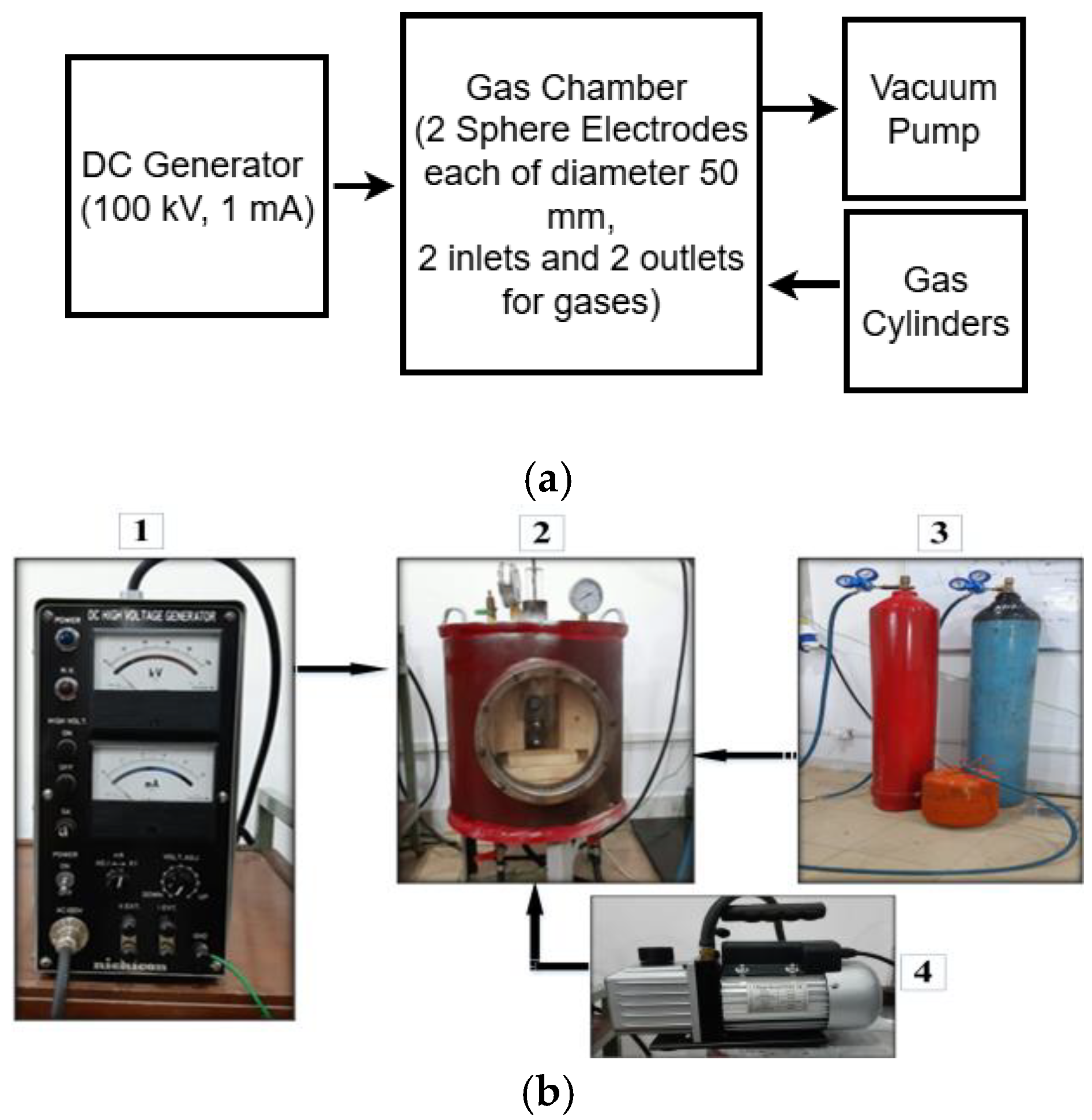

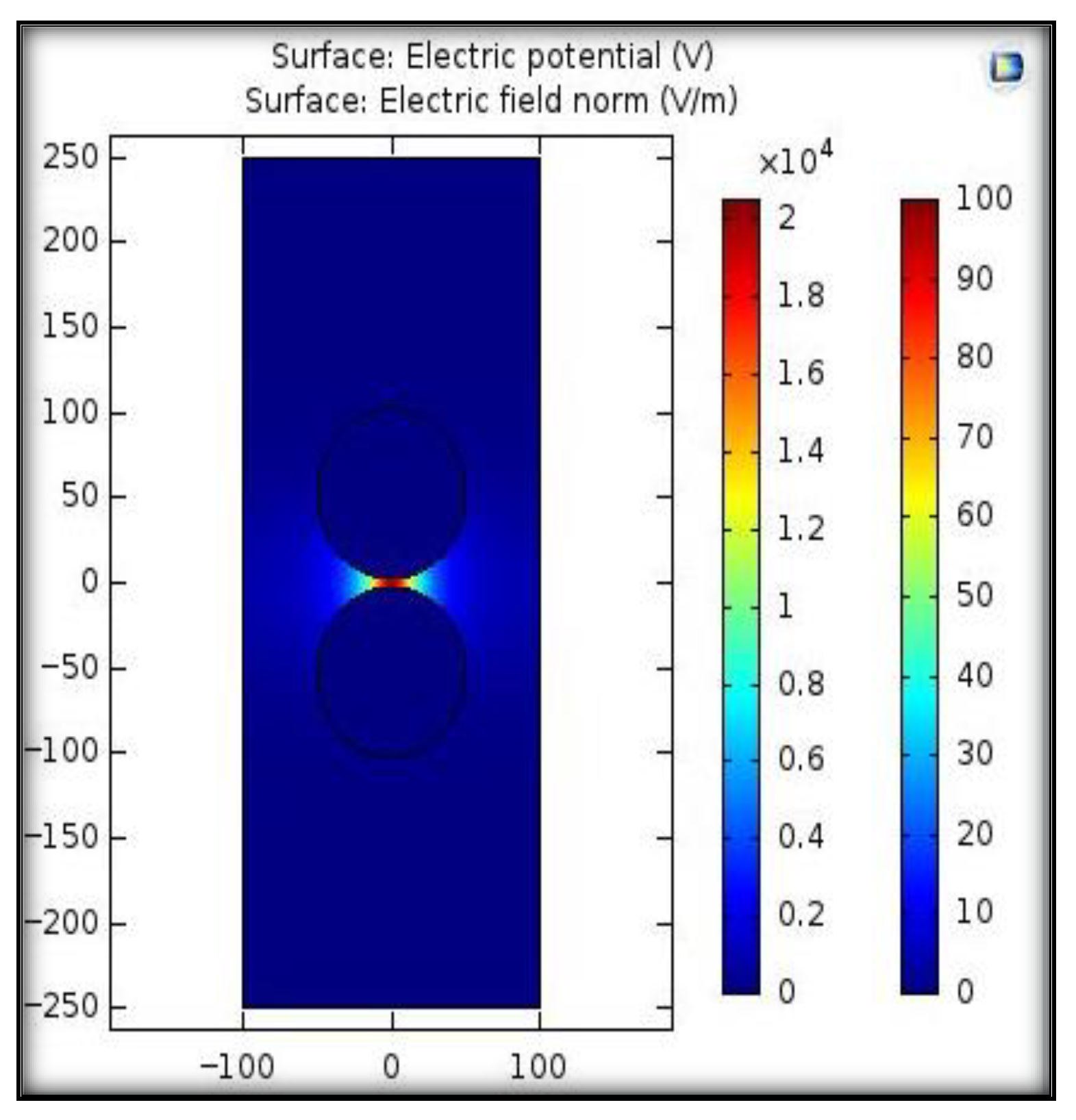
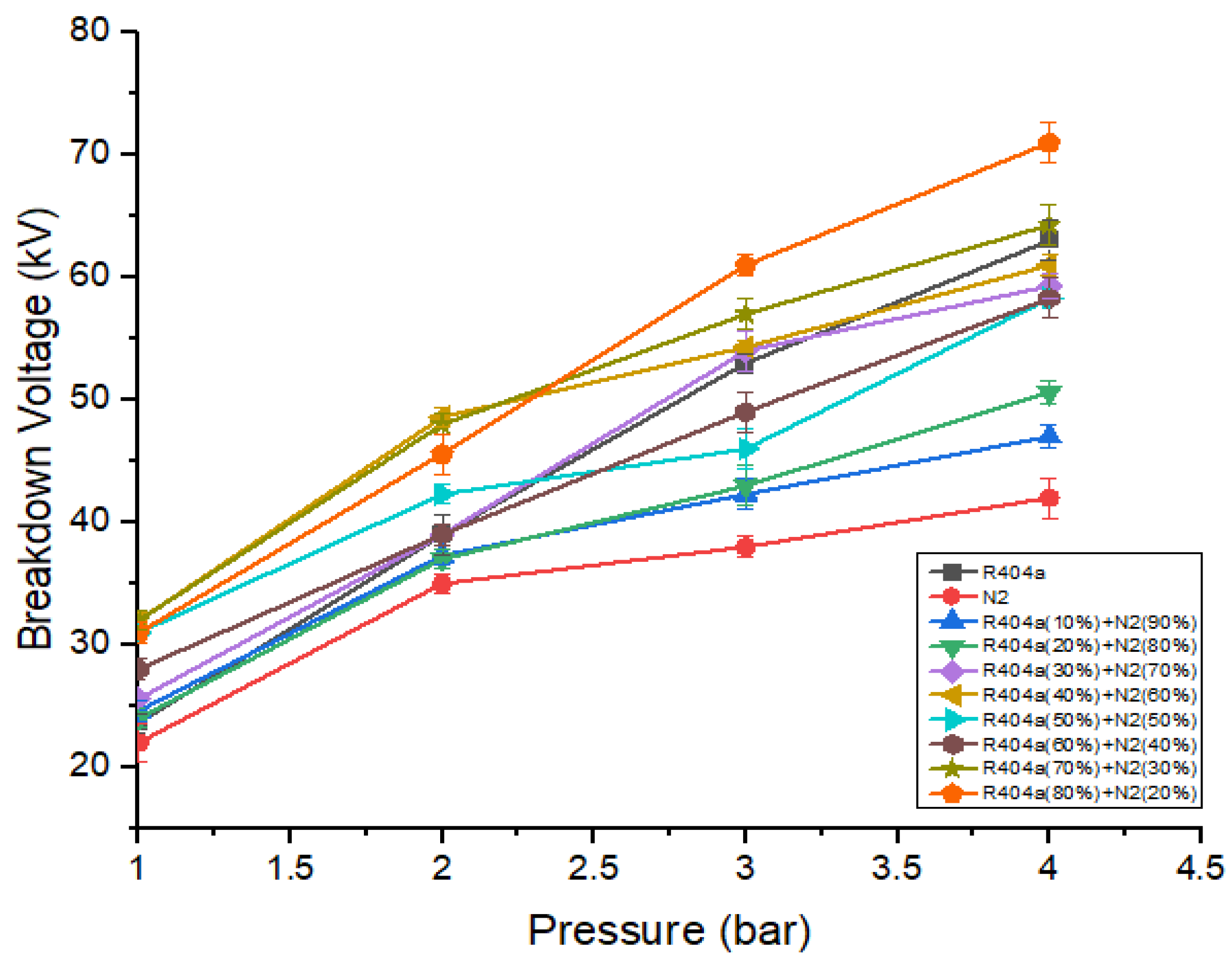
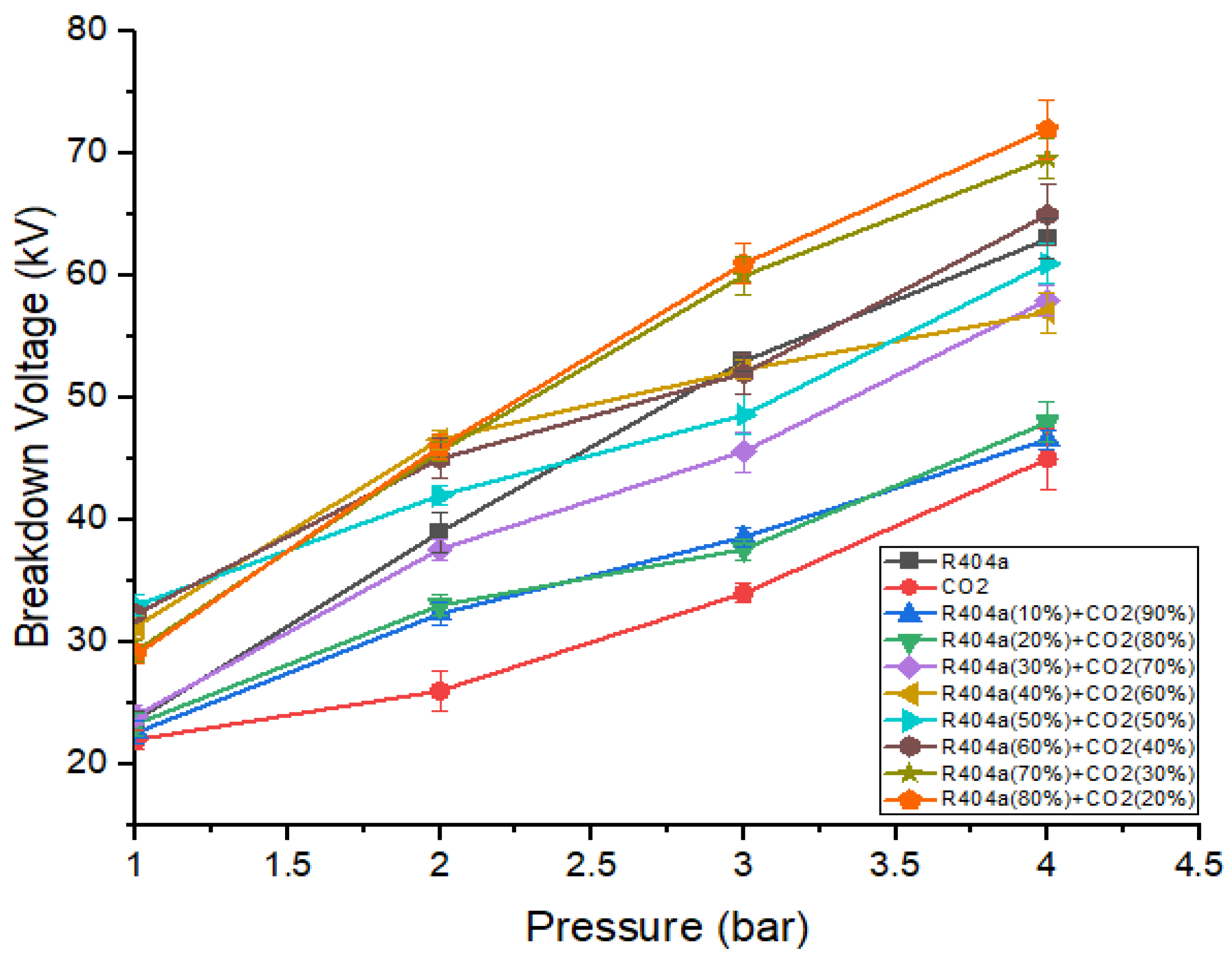
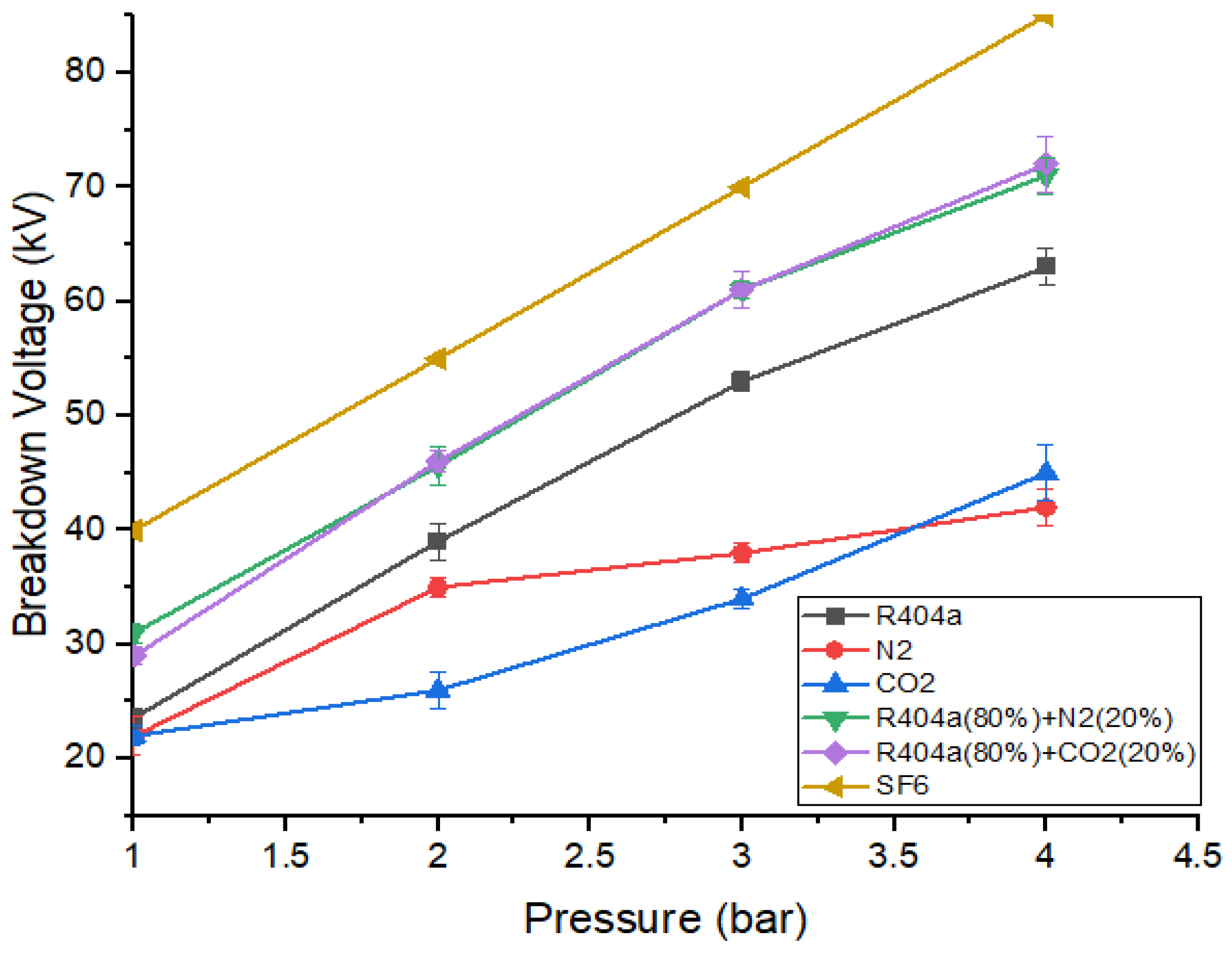
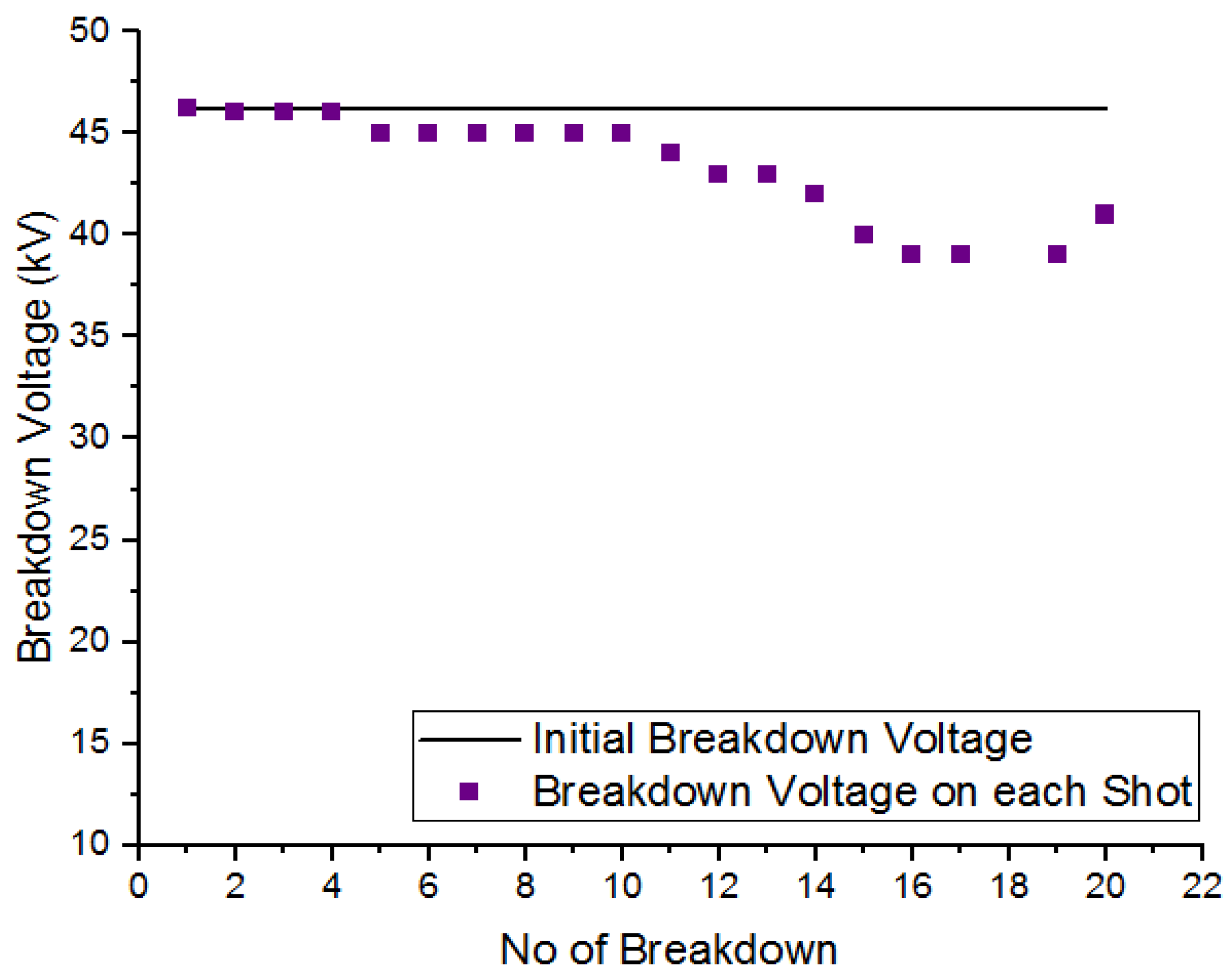
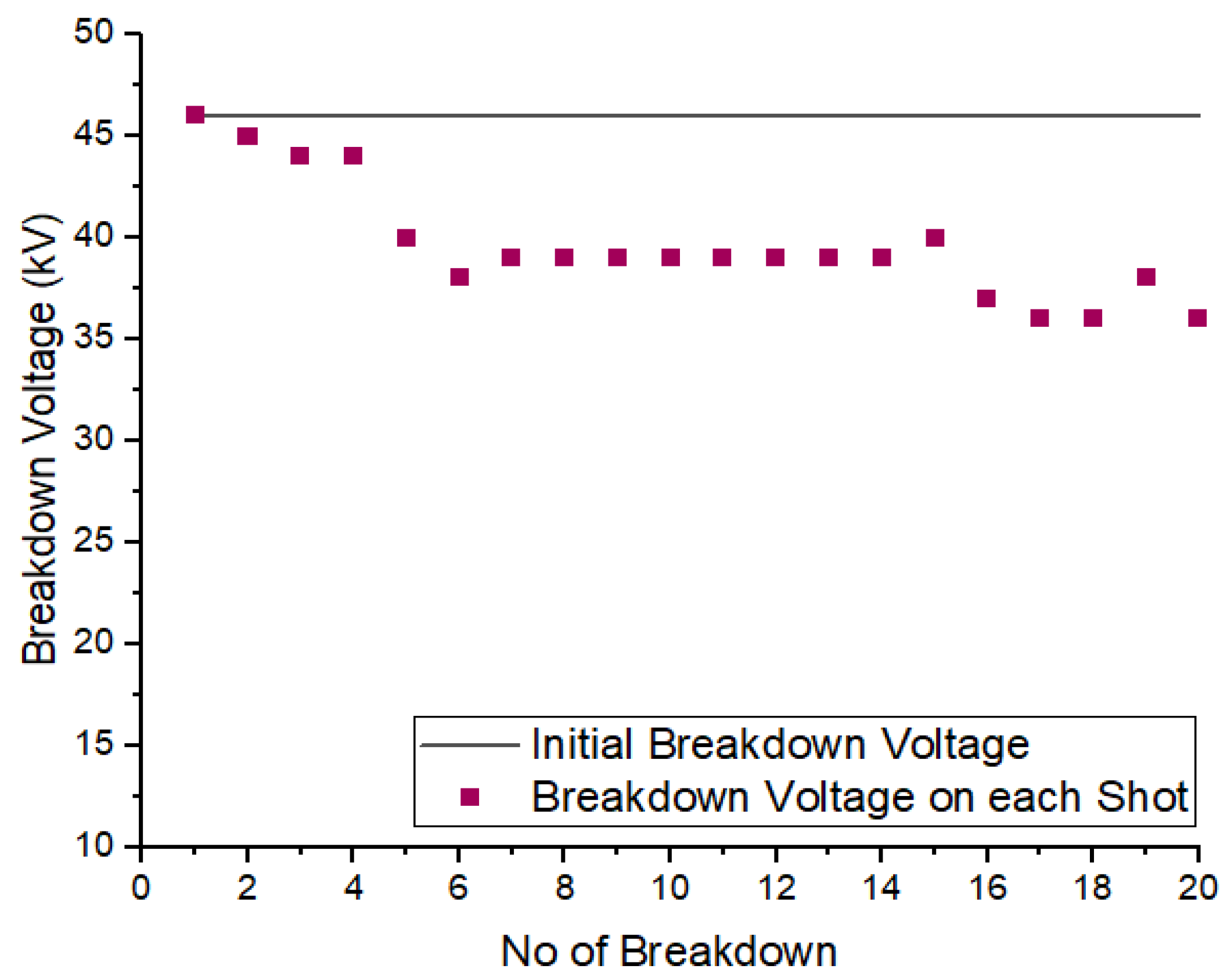
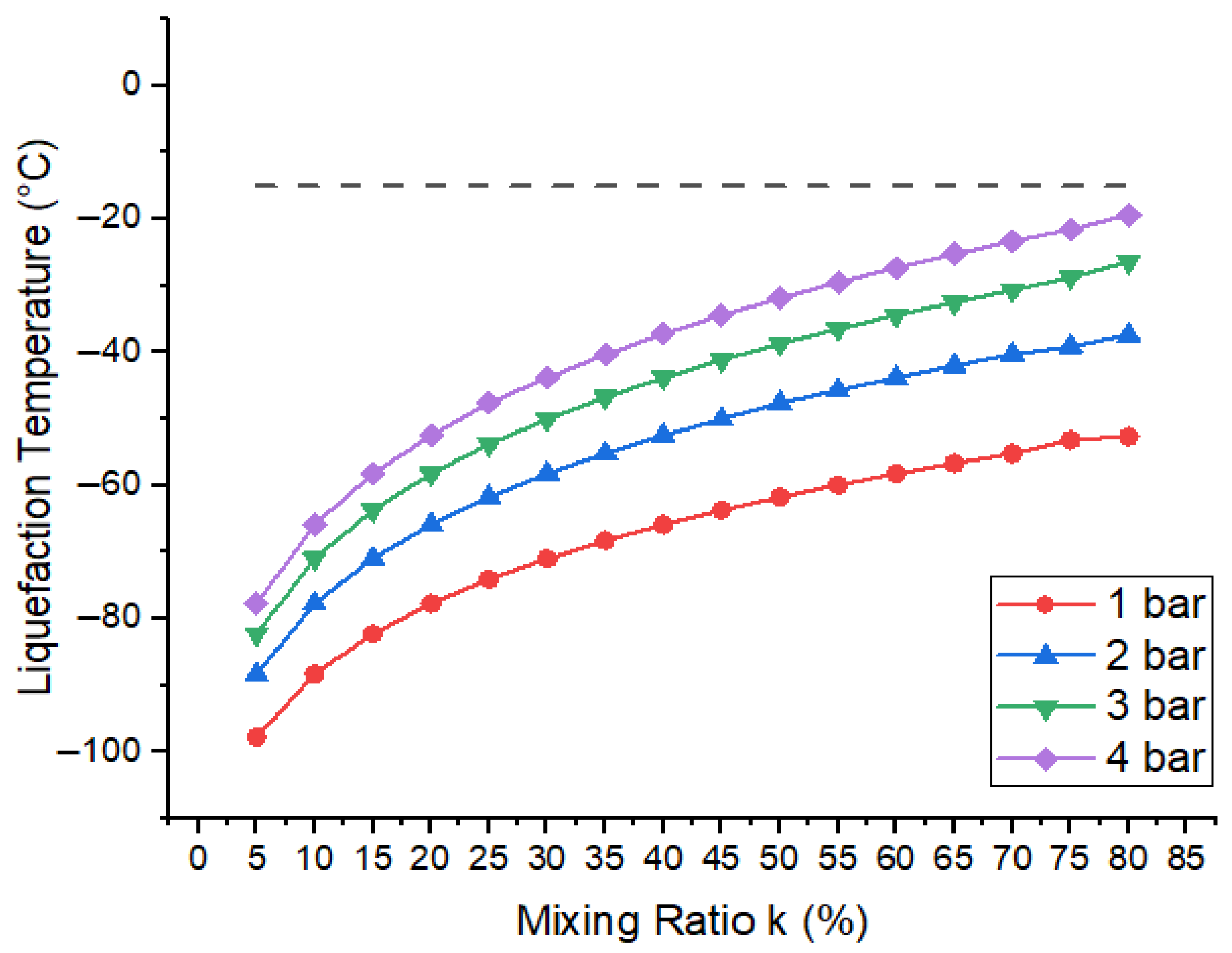
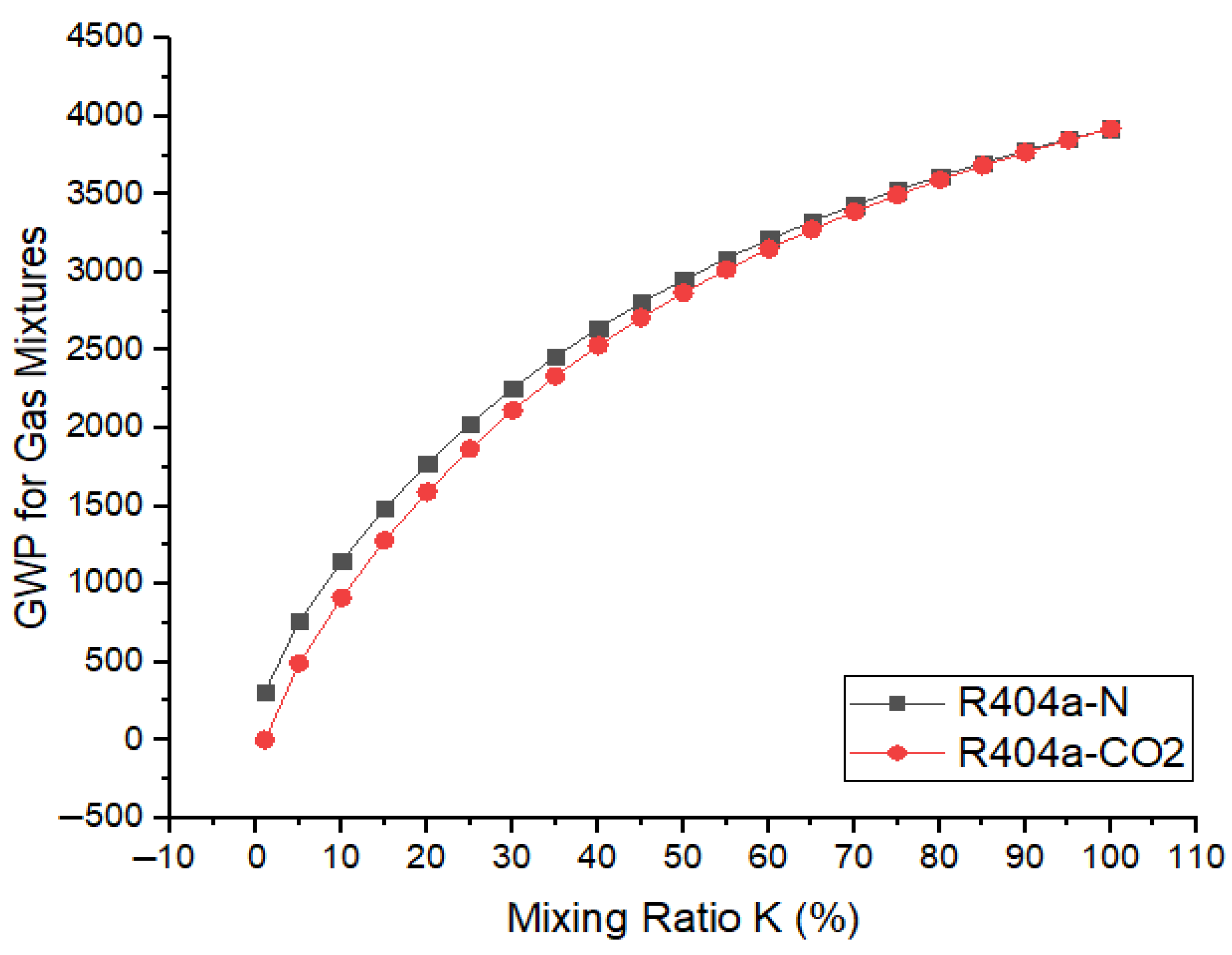
| Reference | Chemical Formula | Breakdown Strength vs. SF6 | GWP (Per 100 Years) | Boiling Point (°C) | Atmospheric Life (Years) |
|---|---|---|---|---|---|
| [16] | SF6 | 1 | 23,500 | −64.3 | 3200 |
| [17] | C4F7N | 2.74 | 2100 | −4.7 | 30 |
| [17] | C5F10O | 1.31 | <1 | 27 | 0.04 |
| [18] | C6F12O | 1.7 | 1 | 49.2 | 0.04 |
| [19,20] | CF3NSF2 | 2.41 | - | −6 | 10 |
| [21] | C3F8 | 1.01 | 7000 | −36.7 | 2600 |
| [20,22] | C3H2F4 | 0.98 | 0.02 | −9 | 0.045 |
| [23] | C2HF5/C3H2F5 | 0.92–0.95 | 3985 | −46.7 | - |
| [24,25] | C4H2F6 | 1.2–1.6 | 18 | 7.5 | Few days |
| [26] | CHClF2 | 0.85–0.86 | 1810 | −40.7 | 11.8 |
| Name of Component | Chemical Formula | Weight (%) |
|---|---|---|
| Pentafluoroethane (R125) | 44 | |
| 1,1,1–Trifluoroethane (R143a) | 52 | |
| 1,1,1,2–Tetrafluoroethane (R134a) | 4 |
| Property (at 25 °C) | R404a | SF6 |
|---|---|---|
| GWP | 3922 | 23,500 |
| Boiling point (°C) | −47.8 | −64.3 |
| ODP | 0 | 0 |
| Flash point (°C) | None | None |
| Molecular weight (g/mol) | 120 | 146 |
| Pressure (bar) | Mixing Ratio k (%) | ||||
|---|---|---|---|---|---|
| 20 | 40 | 60 | 80 | ||
| 1 | −0.07 | −0.6 | −1.1 | −3.2 | |
| 2 | 0.2 | −0.5 | 0.6 | −2.5 | |
| 3 | 0.5 | −0.05 | 0.5 | −1.4 | |
| 4 | 0.4 | 0.07 | 0.4 | −1.1 | |
| Pressure (bar) | Mixing Ratio k (%) | ||||
|---|---|---|---|---|---|
| 20 | 40 | 60 | 80 | ||
| 1 | 0.05 | −0.5 | −1.2 | −3.0 | |
| 2 | 0.2 | −0.2 | −0.5 | −1.4 | |
| 3 | 1.0 | 0.02 | 0.08 | −1.2 | |
| 4 | 1.2 | 0.3 | −0.1 | −1.3 | |
Disclaimer/Publisher’s Note: The statements, opinions and data contained in all publications are solely those of the individual author(s) and contributor(s) and not of MDPI and/or the editor(s). MDPI and/or the editor(s) disclaim responsibility for any injury to people or property resulting from any ideas, methods, instructions or products referred to in the content. |
© 2025 by the authors. Licensee MDPI, Basel, Switzerland. This article is an open access article distributed under the terms and conditions of the Creative Commons Attribution (CC BY) license (https://creativecommons.org/licenses/by/4.0/).
Share and Cite
Riaz, H.; Saleem, M.Z.; Faheem, M. Investigation of DC Breakdown Properties of Low GWP Gas R404a and Its Mixtures with N2/CO2 as an Alternative to SF6. Processes 2025, 13, 2247. https://doi.org/10.3390/pr13072247
Riaz H, Saleem MZ, Faheem M. Investigation of DC Breakdown Properties of Low GWP Gas R404a and Its Mixtures with N2/CO2 as an Alternative to SF6. Processes. 2025; 13(7):2247. https://doi.org/10.3390/pr13072247
Chicago/Turabian StyleRiaz, Hassan, Muhammad Zaheer Saleem, and Muhammad Faheem. 2025. "Investigation of DC Breakdown Properties of Low GWP Gas R404a and Its Mixtures with N2/CO2 as an Alternative to SF6" Processes 13, no. 7: 2247. https://doi.org/10.3390/pr13072247
APA StyleRiaz, H., Saleem, M. Z., & Faheem, M. (2025). Investigation of DC Breakdown Properties of Low GWP Gas R404a and Its Mixtures with N2/CO2 as an Alternative to SF6. Processes, 13(7), 2247. https://doi.org/10.3390/pr13072247






